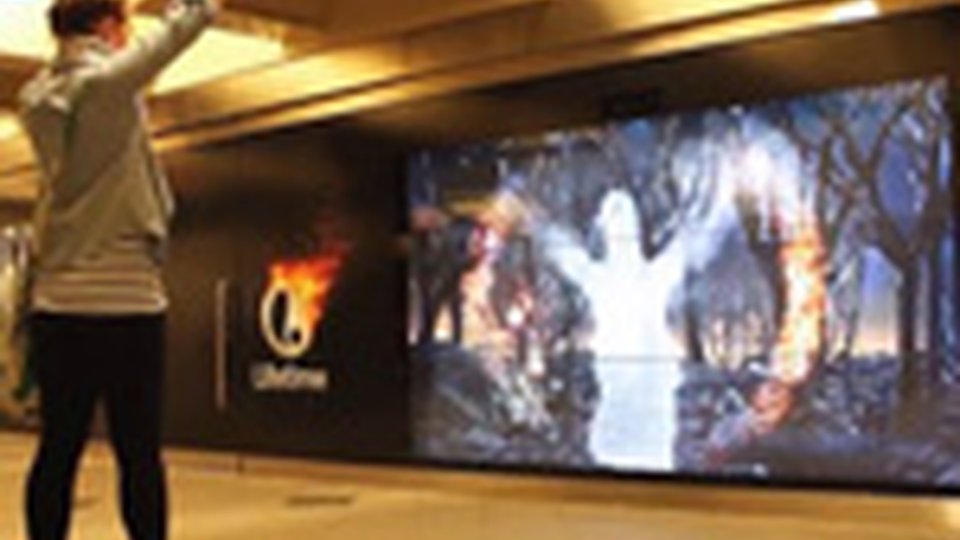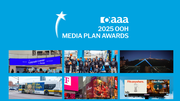Article
Digital signage casts a spell on subway commuters in NYC
Interactive experience designers offer a glimpse into what they say will be the future of digital out-of-home.

October 3, 2013
Gesture-interactive digital signage is bewitching subway commuters in New York City.
Two nine-screen digital signage video walls featuring gesture-interaction capabilities in the busy Columbus Circle subway station are part of the promotional campaign for the new Lifetime TV series, "Witches of East End."
One interactive video wall features gamification of digital signage content that fits thematically with the show. Passersby trigger motion sensors in the video wall, and a large on-screen eye follows their movements. If the passerby stops for about two seconds, the eye's pupil expands, releasing a flock of black birds. The image on display then changes to a dark forest, and the passerby is encouraged to interact with the screens via gestures to combat dark spirits in the forest. Another video wall plays the show's trailer.
The interactive experience was produced by Pearl Media, a firm perhaps better known for its 3D projection-mapping displays but with years of experience in interactive digital signage experiences as well.
"This is going to be a big show for [Lifetime] this fall, so this was something they really wanted to promote and do something a little bit different [for]," Pearl Media CEO Josh Cohen said in an interview. "With the thematic of the show being witches and being a bit spooky, they wanted to do something a little bit out of the box to kind of grab people's attention to the show."
Interactive, whether via touch, gesture or other means, is the future of digital out-of-home, Cohen said. The gesture interaction for this deployment was achieved through Microsoft Kinect technology, Cohen said, and the video walls were made up of 43-inch, ultra-HD, ultra-narrow bezel digital signage displays.
"The digital screen now, which is replacing the static image, when it's just flipping and showing normal content it doesn't really do much more than show a digital static image," he said. "But when we're able to allow people to interact — whether it's gesture, mobile, social, touch, photo-capture, augmented reality — it allows consumers to have a personal connection to the advertisement, to the client, to create what we call a lasting impression and increase the opportunity for them to share via mobile and social, which I think is a big part of the digital signage interactive opportunities, which are sometimes missed in just your traditional digital signage."
The interactive element creates a sense of excitement, engagement and creativity, Cohen said, along with the ability to be able to share socially, or to interact further with the brand. "Definitely the retention of that ad from a consumer standpoint is going to be much greater than just a standard static or traditional video advertisement."
Pearl Media CMO Joe DePreta said that, while the only consistency in this business is inconsistency, one of the things that has been consistent in recent years and will probably continue to be so into the future, is the desire for brands to engage with consumers.
"What all advertisers are looking for are better ways to trigger consumer engagement, getting past the 30-second TV ad," DePreta said in an interview, "and what these kinds of interactive digital experiences offer is exactly that, ongoing conversation between consumer and brand in a way that's prolonged, engaged and content driven."
This particular deployment did not have a social media or mobile context for continued brand/consumer dialogue, although DePreta said that about half of the people who stop to engage with the experience have captured it on their smartphone and then shared it.
But that omission was by design, taking into consideration the location of the experience, Cohen said.
"This was almost like a shock-and-awe type of strategy," Cohen said. "The other thing, when you get into all of these interactive experiences, is knowing your audience. Being down in Columbus Circle where consumers' main goal is to get in and out of the subway as quick as possible, you want to create something that's exciting, energetic but concise."
Especially in New York City, Cohen said, commuters aren't likely to stand still or stop for a four- or five-minute engagement, so the experience needs get the advertiser's message across quickly to keep them engaged, and then let them move on.
"So we take that into consideration when we're developing these experiences, 'What is the environment we're going to be in?'" he said. "If this was going to be a mall application, we might make the experience a little bit longer, or at a state fair or something for that matter, but knowing that we're working in the transit sector we know that we actually really only have a New York minute, and we want to make the most of that."
Watch a video of subway commuters interacting with the video wall below:
Learn more about DOOH advertising.







